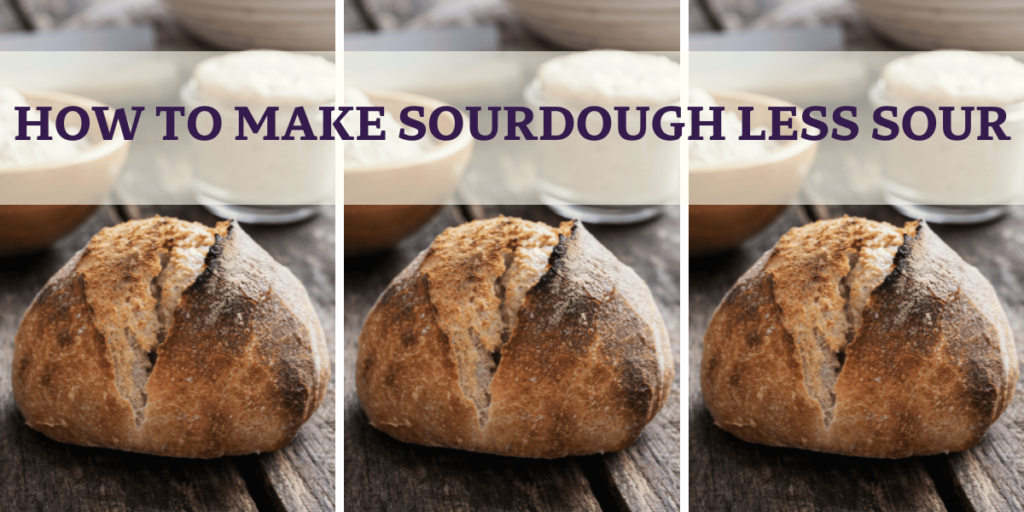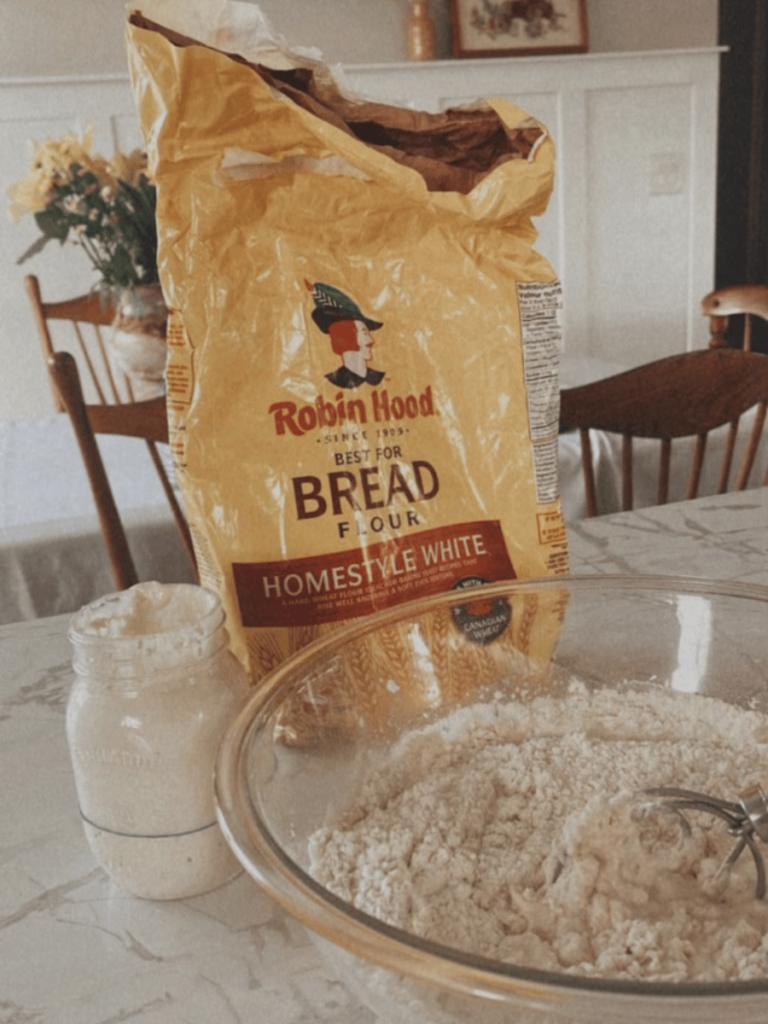
Lets learn how to make sourdough less sour! Sourdough bread has captured the hearts of home bakers, health-conscious consumers, and food enthusiasts worldwide. Its rise in popularity is not just a fleeting trend but a return to traditional methods of bread-making that date back thousands of years. Sourdough’s rich history and unique flavor profile make it a favorite among those who seek a more authentic and fulfilling baking experience.
In this guide, we will explore the art of making sourdough bread with a specific focus on how to reduce its sourness. Whether you’re a seasoned baker or just starting your baking journey, you’ll find valuable tips and insights to help you craft a loaf that’s perfect for your taste. Let’s get started on this exciting adventure into the world of sourdough!
This Post Is All About How To Make Sourdough Less Sour
The Tradition of Sourdough
A Timeless Tradition
Sourdough bread has been a staple in human diets for millennia. Its origins can be traced back to ancient Egypt, where the fermentation process was discovered. This method allowed for the natural leavening of bread using wild yeast and lactic acid bacteria.
The Recent Sourdough Revival
In recent years, sourdough has experienced a renaissance. With the rise of artisanal bakeries and a growing interest in homesteading and self-sufficiency, more people are turning to sourdough as a healthier and more satisfying alternative to commercial bread.
Why Sourdough?
Sourdough’s appeal lies in its complex flavors and health benefits. The fermentation process breaks down complex carbohydrates, making it easier to digest. Additionally, the natural acidity helps preserve the bread, reducing the need for preservatives.
RELATED POSTS: How Long To Proof Sourdough: A Guide For Best Proofing
The Science Behind Sourdough
Ingredients and Their Roles
At its core, sourdough consists of just a few simple ingredients: flour, water, and salt. However, the magic happens during fermentation, where wild yeast and lactic acid bacteria come into play.
- Flour Type: The type of flour used can significantly impact the flavor and texture of the bread. Whole grain flours like rye and whole wheat contribute to a more robust flavor, while white flour results in a milder taste.
- Water Temperature: The temperature of the water used in the dough mix can influence the fermentation process. Warmer temperatures speed up fermentation, while cooler temperatures slow it down.
- Salt: Salt adds flavor and strengthens the gluten structure, contributing to the overall texture of the bread.
The Fermentation Process
Fermentation is the heart of sourdough baking. It’s where the wild yeast and lactic acid bacteria work together to leaven the bread and develop its unique flavor profile.
- Wild Yeast: Wild yeast is less predictable than commercial yeast but creates a more complex flavor. It thrives in a healthy starter and contributes to the bread’s rise.
- Lactic Acid Bacteria: These bacteria produce lactic acid, which adds tanginess to the bread. Managing their activity is key to controlling the sourness.

Best Practices for Sourdough
To achieve the best results, it’s essential to follow some best practices:
- Healthy Starter: Maintain a healthy starter by feeding it regularly with equal parts water and flour.
- Proper Hydration: Ensure the right hydration level for your dough to develop a good rise.
- Controlled Fermentation: Monitor the fermentation time and temperature to balance the sourness and flavor.
Changing the Flavor Profile of Sourdough
Understanding Sourness
The sourness of sourdough bread is primarily influenced by the activity of lactic acid bacteria and the fermentation process. To make sourdough less sour, it’s crucial to understand these factors.
Different Types of Flour
Choosing the right type of flour can significantly impact the texture, flavour, and rise of your sourdough bread. Here are some popular choices:
- All-Purpose Flour: This versatile flour is a staple in many kitchens and produces a mild, balanced flavour. It’s excellent for beginners due to its consistent results and affordability. Loaves made with all-purpose flour tend to have a lighter crumb and a milder taste.
- Bread Flour: Known for its higher protein content, bread flour is ideal for creating loaves with a chewy texture and a robust rise. The increased gluten development enhances the bread’s structure, making it perfect for those who enjoy a firmer crust and a denser crumb.
- Whole Wheat Flour: Packed with complex carbohydrates and fibre, whole wheat flour gives sourdough a hearty, earthy flavour. However, it can make the dough denser and more challenging to work with due to reduced gluten development. Combining whole wheat with other flours balances flavour and texture.
- Rye Flour: Rye flour infuses sourdough with a deep, complex flavour and enhances the sourness of your bread. The lower gluten content results in a denser loaf, often with a moist crumb and a slightly sticky texture.
- Spelt Flour: An ancient grain with a nutty flavour, spelt flour produces a unique, slightly sweet loaf. It has a lower gluten content than wheat flour, meaning it’s not as strong in structure but is excellent for creating soft, tender crumbs.
- Whole Grain Flour: Using whole grain flour can introduce more wild yeast and lactic acid bacteria, contributing to a more sour taste in your sourdough.
Adjusting Water Temperature
Water temperature plays a vital role in fermentation:
- Warmer Temperatures: Speed up fermentation, leading to a more sour flavor.
- Cooler Temperatures: Slow down fermentation, resulting in a milder taste.
Experimenting with Fermentation Time
The length of fermentation affects the bread’s sourness:
- Long Fermentation: Increases sourness due to prolonged activity of lactic acid bacteria.
- Short Fermentation: Results in a milder flavor as there’s less time for acid production.
Types of Starters in Sourdough Baking
Starters and Their Impact
The type of starter you use plays a crucial role in determining the sourness of your sourdough bread. Let’s explore some common options:
- Liquid Starter: With equal parts flour and water (100% hydration), a liquid starter creates a more open crumb and airy texture. It’s reputed for being faster-acting but can be more challenging to handle due to its higher hydration level. Adjusting the water temperature can help manage the fermentation process.
- Stiff Starter: This type of starter uses a lower water-to-flour ratio (50-60% hydration). A stiffer starter ferments more slowly and results in a denser crumb with a milder sourness. It’s easier to manage and less prone to spoilage.
- Whole Wheat or Rye Starter: Incorporating whole wheat or rye into your starter can boost its activity due to the additional nutrients and wild yeasts present in these whole grains. These starters often lead to a more tangy, complex flavour profile. A whole rye starter can significantly enhance the sourness of sourdough bread.
- Grape Starter: Made by fermenting grapes with flour and water, a grape starter can introduce unique wild yeasts and bacteria into your sourdough, resulting in a distinctive, fruity undertone.
- Mother Culture: A healthy starter or mother culture ensures a strong fermentation cycle, producing more acetic acid and citric acid, which contribute to the sourdough flavor.
Fermentation and Proofing
The fermentation time and environment play crucial roles in the development of your bread dough:
- Bulk Fermentation: This is the first rise of the dough, where the dough ferments at room temperature or cooler temps. Bulk fermentation allows the lactic acid bacteria and wild yeast to develop, impacting the dough rise and final bread flavor. Bulk fermentation in cooler temperatures can lead to a more acetic acid-dominant flavor, producing sourer bread.
- Cold Ferment: Allowing the dough to ferment in cooler temperatures for a long time can enhance the sourness of your sourdough bread by increasing the activity of acid producers.
- Final Proof: Proofing the dough at the right temperature is essential for a good rise. Warmer temperatures can speed up the fermentation process but may result in a less sour flavor profile.
Outcomes of Different Combinations
Combining different flours and starters can yield varied and exciting results in your sourdough baking:
- All-Purpose Flour with Liquid Starter: Perfect for lighter, airier loaves with delicate flavours, ideal for sandwiches and everyday use.
- Bread Flour with Stiff Starter: Yields sturdy, chewy loaves with superior structure, great for hearty, rustic bread.
- Whole Wheat Flour with Whole Wheat Starter: Produces rich, dense loaves with an earthy taste, suitable for health-conscious bakers.
- Rye Flour with Rye Starter: Results in deeply flavoured, somewhat sour loaves with a moist crumb, excellent for traditional rye bread.
- Combination of Spelt Flour and Grape Starter: Creates unique, slightly sweet, and chewy loaves with a fruity essence, perfect for special occasions and gourmet meals.
- Whole Grain Flour with Active Starter: Ideal for more sour bread with robust flavors.
By experimenting with different flours, starters, and fermentation processes, you can discover the perfect combination that suits your taste and preferences, turning the art of sourdough baking into an adventurous and rewarding journey. Using a dutch oven is an easy way to ensure a good rise and crust.
Tips On How To Make Your Sourdough Less Sour
Managing Your Starter
A well-maintained starter is key to controlling sourness:
- Feed Regularly: Feed your starter with equal parts water and flour to keep it active and healthy.
- Use a Stiff Starter: A stiffer starter (with lower hydration) can reduce sourness.
- Discard and Refresh: Regularly discard a portion of your starter before feeding to maintain balance.
Optimal Fermentation Conditions
Adjust fermentation conditions to achieve desired sourness:
- Control Temperature: Use cooler temperatures during bulk fermentation to slow down acid production.
- Monitor Time: Shorten the fermentation time to reduce sour flavor.
- Final Proof: Allow enough time for the dough to rise, but avoid overproofing as it increases sourness.
Ingredient Selection
The type of ingredients used can influence the flavor:
- Whole Grain Flour: Incorporate whole grains for a more complex but less sour taste.
- Purpose Flour: Use a blend of white and whole grain flours for balance.
- Citric Acid: Adding a small amount of citric acid can neutralize some of the sourness.
Start with a Mild Starter
A mild starter sets the foundation for less sour bread:
- Create a New Starter: If your current starter is too sour, consider starting a new one with white flour and water.
- Feed Often: Feed the new starter frequently to build up mild flavors.
- Monitor Activity: Ensure the starter is active but not overly acidic.
Adjust Fermentation Techniques
Fine-tune your fermentation techniques to control sourness:
- Shorter Bulk Fermentation: Reduce the bulk fermentation time to limit acid production.
- Cooler Fermentation: Ferment the dough at cooler temperatures to slow down the activity of lactic acid bacteria.
- Cold Ferment: Consider a cold ferment in the refrigerator to further reduce sourness.
Baking Methods
Baking methods can also impact the flavor:
- Dutch Oven: Using a Dutch oven can create a consistent baking environment, enhancing the overall taste.
- Steam: Incorporate steam during the initial baking phase to improve crust and texture.
- Lower Heat: Bake at slightly lower temperatures to prevent excessive browning, which can intensify sour notes.
Conclusion
Sourdough baking is a rewarding and adventurous journey that offers endless opportunities for experimentation and discovery. By understanding the science behind sourdough and implementing these practical tips, you can tailor the flavor of your bread to your preference, making it less sour without compromising its unique character.
Remember, the key to success lies in maintaining a healthy starter, adjusting fermentation conditions, and selecting the right ingredients. With patience and practice, you’ll master the art of making sourdough that’s perfectly balanced and irresistibly delicious.
Happy baking!
